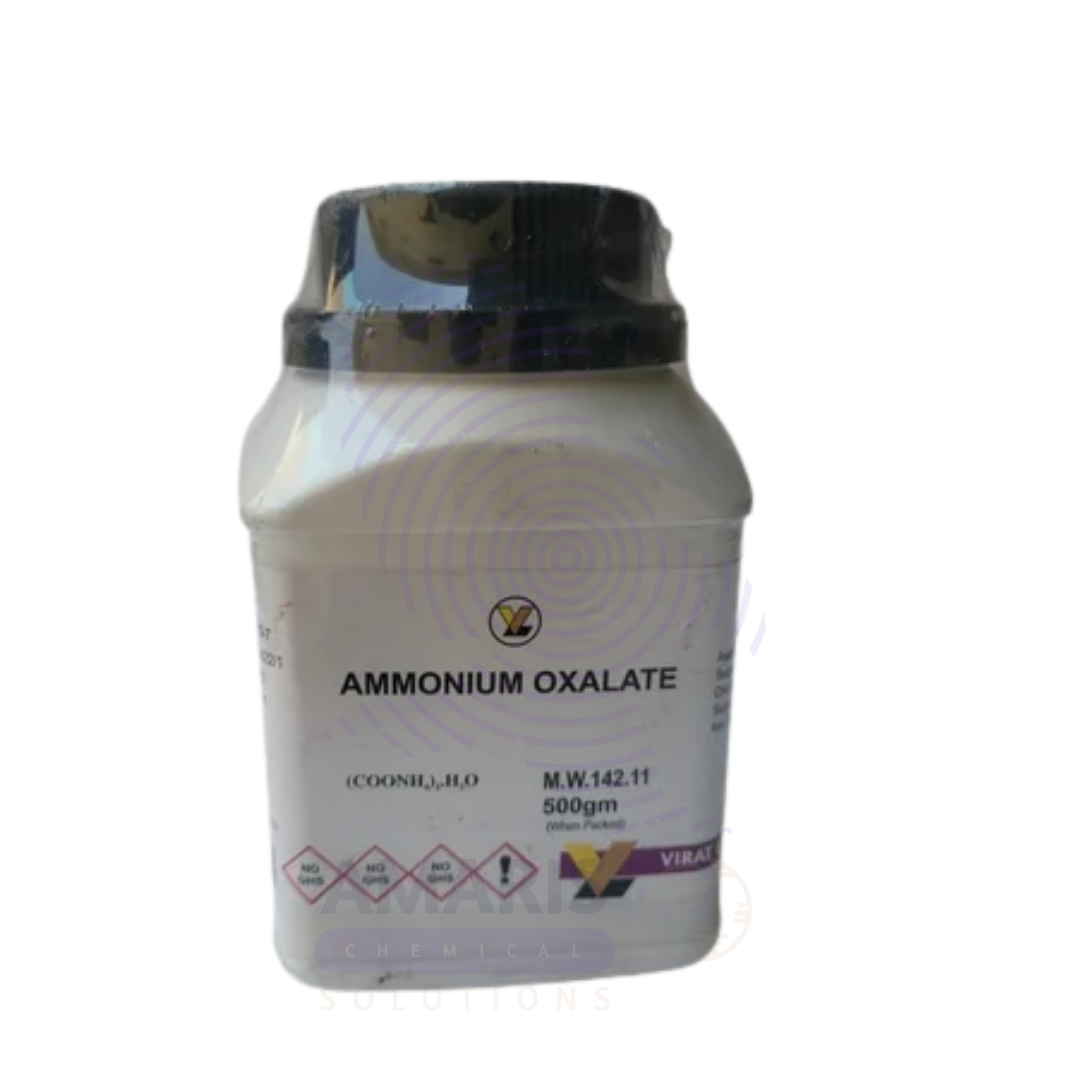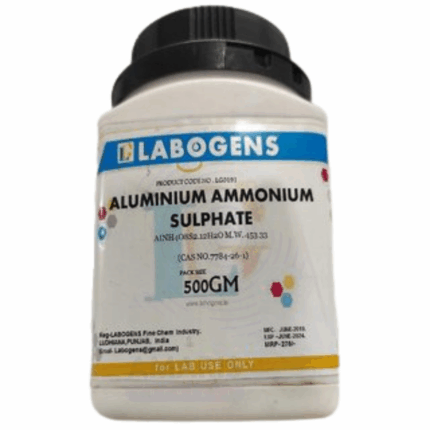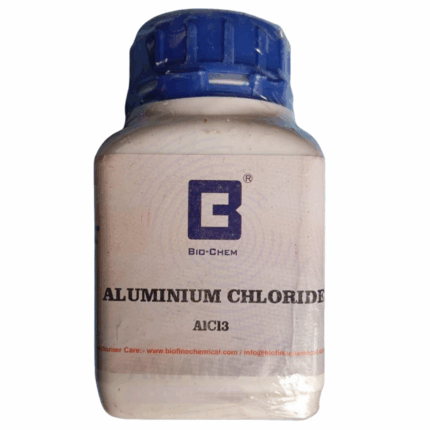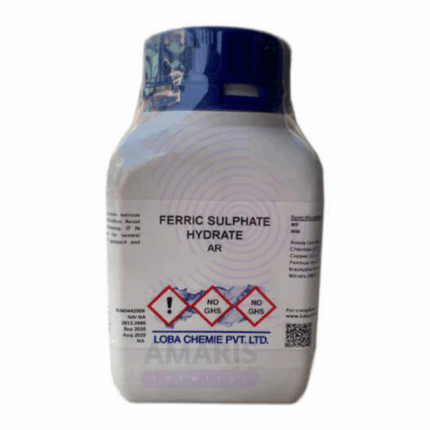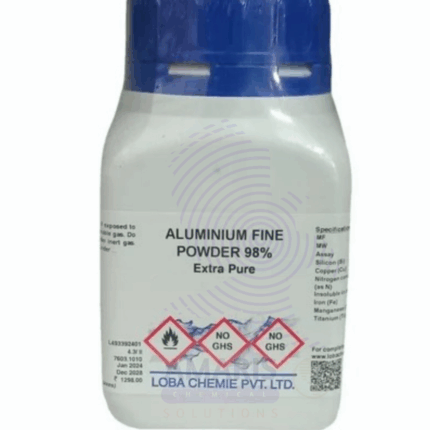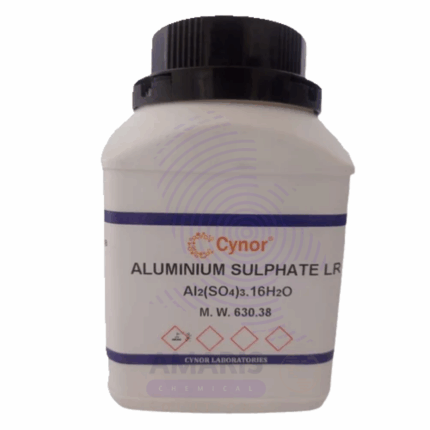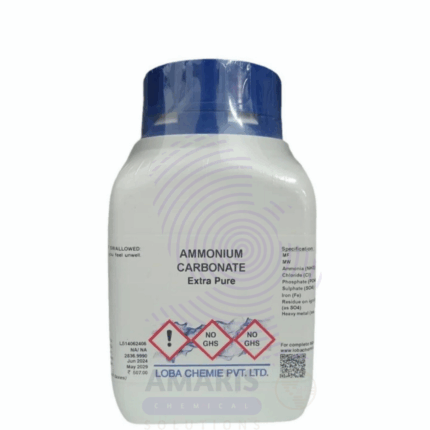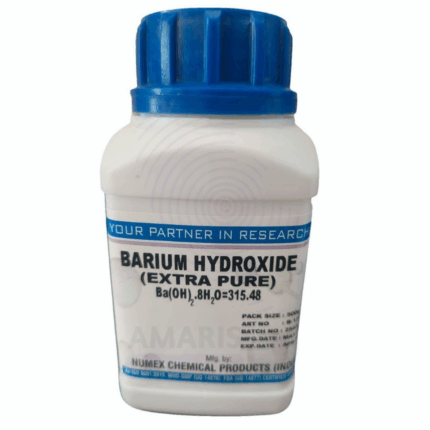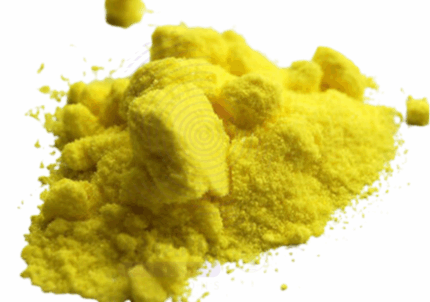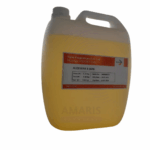
Ammonium Oxalate Extra Pure
$ 19.00 Original price was: $ 19.00.$ 18.96Current price is: $ 18.96.
Ammonium Oxalate Extra Pure is a high-purity, white crystalline compound commonly used in laboratory chemistry for analytical and inorganic applications. It is particularly valuable in the qualitative and quantitative analysis of calcium, where it forms an insoluble calcium oxalate precipitate. This makes it essential in hardness testing of water and other gravimetric determinations. It also finds use in buffer solutions and as a complexing agent in metal ion analysis. The extra pure grade ensures low levels of interfering substances, making it ideal for sensitive analytical work. Ammonium oxalate should be stored in a tightly sealed container in a cool, dry place to maintain stability and prevent degradation.
Ammonium Oxalate Extra Pure
Primary Use
- Reagent for Calcium Ion Detection and Quantification
- Precipitates calcium as calcium oxalate (CaC₂O₄) — widely used in classical gravimetric analysis of calcium in water, food, and biological samples.
- Source of Oxalate Ions in Precipitation Reactions
- Supplies C₂O₄²⁻ for preparing insoluble oxalates of calcium, barium, lanthanides, and transition metals in qualitative analysis.
- Complexometric Reagent in Coordination Chemistry
- Acts as a bidentate ligand to form complexes with Fe³⁺, Cr³⁺, and other metal ions in stability and ligand exchange studies.
- Standard in Redox Titrations (with KMnO₄)
- Oxalate ion is oxidized by permanganate in acidic medium — used in redox titration to determine KMnO₄ concentration.
- Demonstration of Double Salt Formation and Thermal Decomposition
- Used in teaching thermal analysis and precipitation behavior of sparingly soluble salts.
Secondary Uses
- Study of Kidney Stone Formation (Biochemistry/Medical Research)
- Models oxalate metabolism and precipitation under various pH conditions in clinical or pathological studies.
- pH-Dependent Solubility Experiments
- Used in teaching labs to illustrate pH effects on solubility of weak acid salts and metal complexes.
- Fluorometric and Spectrophotometric Metal Detection
- Can enhance detection sensitivity when combined with fluorescent or chromogenic ligands for trace metal analysis.
- Preparation of Oxalate-Based Coordination Compounds
- Used in research involving transition metal oxalates, crystal engineering, or hybrid organic-inorganic materials.
- Buffer Component in Specialized Systems
- Occasionally used in low-pH buffer systems where chelation or reducing behavior is desired.
| PACK SIZE |
500 grams Plastic Tin |
|---|
1. Basic Identification Attributes
- Chemical Name: Ammonium Oxalate
- CAS Number: 1113-38-8 (anhydrous)
- Common Lab Form: Ammonium Oxalate Monohydrate
- CAS Number (Monohydrate): 6009-70-7
- HS Code: 29171100 (Oxalic acid and its salts and esters)
- Molecular Formula: (NH₄)₂C₂O₄ · H₂O (monohydrate)
- Synonyms:
- Diammonium oxalate
- Oxalic acid diammonium salt
- Ammonium ethanedioate
- Ammonium oxalate monohydrate
2. Physical & Chemical Properties
- Physical State: Solid (crystalline powder)
- Color & Odor: White crystals; odorless
- Boiling Point: Decomposes before boiling
- Melting Point: Decomposes at ~70–100 °C (monohydrate)
- Density/Specific Gravity: ~1.5 g/cm³ (monohydrate)
- Solubility:
- Water: Freely soluble (~4.2 g/100 mL at 20 °C)
- Alcohol: Slightly soluble
- pH Level: ~6.4 (0.1 M solution)
- Vapor Pressure: Negligible
- Flash Point: Not flammable
- Autoignition Temperature: Not applicable
- Viscosity: Not applicable
3. Safety & Hazard Attributes
- Hazard Class (GHS):
- Acute Toxicity – Oral (Category 4)
- Eye Irritation (Category 2A)
- Skin Irritation (Category 2)
- NFPA Ratings:
- Health: 2
- Flammability: 0
- Reactivity: 0
- Exposure Limits:
- No OSHA PEL/ACGIH TLV established
- Use dust control and general PPE
- Reactivity:
- Stable under normal lab conditions
- Incompatible with strong oxidizers and acids (may release oxalic acid)
4. Storage & Handling Attributes
- Storage Conditions:
- Store in a cool, dry, tightly closed container
- Avoid moisture and direct light
- Incompatible Materials:
- Strong oxidizers, strong acids, calcium or heavy metal salts (forms insoluble oxalates)
- Container Type:
- Sealed plastic or glass container
- Shelf Life & Expiration Date:
- ~2 years under dry conditions
- Special Handling Requirements:
- Use gloves, goggles, lab coat
- Avoid inhalation or ingestion
5. Regulatory & Compliance Attributes
- Regulatory Status:
- Listed under TSCA and REACH
- Regulated due to toxicity and potential to form insoluble oxalate precipitates
- Transportation Restrictions:
- Not classified as hazardous for transport
- Waste Disposal Method:
- Collect as hazardous waste
- Avoid release to drains due to oxalate precipitation with calcium and magnesium
6. Environmental & Health Impact
- Ecotoxicity:
- Toxic to aquatic life in high concentrations
- Persistence in Environment:
- Oxalates may persist and complex with soil minerals
- Carcinogenicity/Mutagenicity:
- Not classified as carcinogenic
- Biodegradability:
- Inorganic salt; not biodegradable, but oxalate ions can be broken down by soil microbes
SAFETY PRECAUTIONS
- Personal Protective Equipment (PPE):
- Wear a lab coat, safety goggles, and chemical-resistant gloves (e.g., nitrile).
- Use in a fume hood or well-ventilated area to avoid dust exposure.
- Handling:
- Avoid inhalation, ingestion, and skin or eye contact.
- Do not allow contact with acids — releases toxic oxalic acid.
- Keep away from oxidizing agents and strong bases.
- Storage:
- Store in a tightly closed container in a cool, dry, well-ventilated location.
- Protect from moisture and light.
- Label container clearly as toxic and harmful if swallowed.
- Hygiene Measures:
- Wash hands thoroughly after handling.
- Do not eat, drink, or smoke during use.
- Clean all surfaces and equipment after use.
FIRST AID MEASURES
- Inhalation:
- Move the person to fresh air immediately.
- Provide oxygen if breathing is difficult.
- Seek medical attention—oxalates can irritate the respiratory tract.
- Skin Contact:
- Wash affected area with plenty of soap and water.
- Remove contaminated clothing.
- Seek medical attention if irritation or burns develop.
- Eye Contact:
- Rinse eyes gently with plenty of water for at least 15 minutes.
- Hold eyelids apart and remove contact lenses if present.
- Seek immediate medical attention.
- Ingestion:
- Rinse mouth with water.
- Do not induce vomiting.
- Give water or milk if the person is conscious.
- Seek immediate medical attention — oxalates are toxic, especially to kidneys and may bind calcium, causing systemic effects.
FIRE FIGHTING MEASURES
- Suitable Extinguishing Media:
- Use dry chemicals, CO₂, foam, or water spray depending on the surrounding materials.
- Specific Hazards:
- Not flammable, but on heating may release:
- Ammonia
- Carbon monoxide (CO)
- Nitrogen oxides (NOₓ)
- Oxalic acid vapors
- Not flammable, but on heating may release:
- Protective Equipment for Firefighters:
- Wear self-contained breathing apparatus (SCBA) and full protective clothing.
- Firefighting Instructions:
- Avoid breathing fumes or decomposition gases.
- Cool containers exposed to heat with water spray.
- Prevent run-off—can be harmful to aquatic life.
Related products
Aluminium Ammonium Sulphate Extra Pure
Aluminium Chloride Anhydrous Extra Pure
Aluminium Ferric Sulphate Extra Pure
Aluminium Metal Fine Extra Pure
Aluminium Sulphate Anhydrous Extra Pure
Ammonium Carbonate Extra Pure
Ammonium Carbonate Extra Pure is a high-quality, white crystalline solid widely used across various scientific, industrial, and food-related applications. Manufactured to stringent purity standards, this compound is ideal for laboratories and processes that demand high-grade reagents. With its characteristic ammonia-like odor and ability to decompose upon heating, ammonium carbonate plays a versatile role in both chemical reactions and physical processes.
In aqueous solution, ammonium carbonate breaks down into ammonium bicarbonate and ammonium carbamate, further releasing ammonia (NH₃) and carbon dioxide (CO₂) upon heating. This property makes it especially useful in applications that require controlled gas release or temporary pH modification.


 Preservatives(food)
Preservatives(food) Flavor Enhancers
Flavor Enhancers Acidulants
Acidulants Sweeteners
Sweeteners Antioxidants
Antioxidants Colorants(food)
Colorants(food) Nutraceutical Ingredients (food)
Nutraceutical Ingredients (food) Nutrient Supplements
Nutrient Supplements Emulsifiers
Emulsifiers
 Collectors
Collectors Dust Suppressants
Dust Suppressants Explosives and Blasting Agents
Explosives and Blasting Agents Flocculants and Coagulants
Flocculants and Coagulants Frothers
Frothers Leaching Agents
Leaching Agents pH Modifiers
pH Modifiers Precious Metal Extraction Agents
Precious Metal Extraction Agents
 Antioxidants(plastic)
Antioxidants(plastic) Colorants (Pigments, Dyes)
Colorants (Pigments, Dyes) Fillers and Reinforcements
Fillers and Reinforcements Flame Retardants
Flame Retardants Monomers
Monomers Plasticizers
Plasticizers Polymerization Initiators
Polymerization Initiators Stabilizers (UV, Heat)
Stabilizers (UV, Heat)
 Antifoaming Agents
Antifoaming Agents Chelating Agents
Chelating Agents Coagulants and Flocculants
Coagulants and Flocculants Corrosion Inhibitors
Corrosion Inhibitors Disinfectants and Biocides
Disinfectants and Biocides Oxidizing Agents
Oxidizing Agents pH Adjusters
pH Adjusters Scale Inhibitors( water)
Scale Inhibitors( water)
 Antioxidants(cosmetic)
Antioxidants(cosmetic) Emollients
Emollients Fragrances and Essential Oils
Fragrances and Essential Oils Humectants
Humectants Preservatives
Preservatives Surfactants(cosmetic)
Surfactants(cosmetic) Thickeners
Thickeners UV Filters
UV Filters
 Fertilizers
Fertilizers Soil Conditioners
Soil Conditioners Plant Growth Regulators
Plant Growth Regulators Animal Feed Additives
Animal Feed Additives Biostimulants
Biostimulants Pesticides (Herbicides, Insecticides, Fungicides)
Pesticides (Herbicides, Insecticides, Fungicides)
 Active Pharmaceutical Ingredients (APIs)
Active Pharmaceutical Ingredients (APIs) Excipients
Excipients Solvents(pharmaceutical)
Solvents(pharmaceutical) Antibiotics
Antibiotics Antiseptics and Disinfectants
Antiseptics and Disinfectants Vaccine Adjuvants
Vaccine Adjuvants Nutraceutical Ingredients (pharmaceutical)
Nutraceutical Ingredients (pharmaceutical) Analgesics & Antipyretics
Analgesics & Antipyretics
 Analytical Reagents
Analytical Reagents Solvents(lab)
Solvents(lab) Chromatography Chemicals
Chromatography Chemicals Spectroscopy Reagents
Spectroscopy Reagents microbiology-and-cell-culture-reagents
microbiology-and-cell-culture-reagents Molecular Biology Reagents
Molecular Biology Reagents Biochemical Reagents
Biochemical Reagents Inorganic and Organic Standards
Inorganic and Organic Standards Laboratory Safety Chemicals
Laboratory Safety Chemicals Specialty Laboratory Chemicals(Special Laboratory Equipment)
Specialty Laboratory Chemicals(Special Laboratory Equipment)
 Demulsifiers
Demulsifiers Hydraulic Fracturing Fluids
Hydraulic Fracturing Fluids Scale Inhibitors(oil)
Scale Inhibitors(oil) Surfactants(oil)
Surfactants(oil) Drilling Fluids
Drilling Fluids
 Dyes and Pigments
Dyes and Pigments Bleaching Agents
Bleaching Agents Softening Agents
Softening Agents Finishing Agents
Finishing Agents Antistatic Agents
Antistatic Agents
 Admixtures
Admixtures Waterproofing Agents
Waterproofing Agents Sealants and Adhesives
Sealants and Adhesives Curing Compounds
Curing Compounds Concrete Repair Chemicals
Concrete Repair Chemicals Anti-Corrosion Coatings
Anti-Corrosion Coatings
 Surfactants(cleaning)
Surfactants(cleaning) Builders
Builders Enzymes
Enzymes Solvents (Cleaning)
Solvents (Cleaning) Fragrances
Fragrances
 Electronic Chemicals
Electronic Chemicals Catalysts
Catalysts Lubricants
Lubricants Photographic Chemicals
Photographic Chemicals Refrigerants
Refrigerants Automotive chemicals
Automotive chemicals Pyrotechnic Chemicals
Pyrotechnic Chemicals
 Biodegradable Surfactants
Biodegradable Surfactants Bio-based Solvents
Bio-based Solvents Renewable Polymers
Renewable Polymers Carbon Capture Chemicals
Carbon Capture Chemicals Wastewater Treatment Chemicals
Wastewater Treatment Chemicals
 Pigments
Pigments Solvents(paint)
Solvents(paint) Specialty Coatings
Specialty Coatings Binders/Resins
Binders/Resins Additives
Additives Driers
Driers Anti-Corrosion Agents
Anti-Corrosion Agents Functional Coatings
Functional Coatings Application-Specific Coatings
Application-Specific Coatings
 Fresh Herbs
Fresh Herbs Ground Spices
Ground Spices Whole Spices
Whole Spices Spice Blends
Spice Blends Dried Herbs
Dried Herbs
 Leavening Agents
Leavening Agents Dough Conditioners
Dough Conditioners Flour Treatments
Flour Treatments Fat Replacers
Fat Replacers Decoratives
Decoratives Preservatives(baking)
Preservatives(baking)
 Plasticizers & Softeners
Plasticizers & Softeners Reinforcing Agents
Reinforcing Agents Adhesion Promoters
Adhesion Promoters Vulcanizing Agents
Vulcanizing Agents Antidegradants
Antidegradants Blowing Agents
Blowing Agents Fillers & Extenders
Fillers & Extenders Accelerators & Retarders
Accelerators & Retarders